Unravel the intriguing concept of meditating in bed because transforming your sleeping environment into a mindfulness practice can offer a transformative impact on your overall well-being.
Yes, indeed, you can meditate in bed! This is a practice that can be both comfortable and beneficial for your mindfulness journey.
Meditating in bed can be a great way to start your day with positivity or end it with calmness.
This article will delve into the hows and whys, offering a comprehensive guide on the best practices for bed meditation.
It will provide insights into the benefits, potential challenges, and effective techniques to ensure a fruitful meditation experience right in the comfort of your bed.
Stick around to uncover all the details.
Key takeaways:
- Comfort: Bed provides a serene space for meditation.
- Tranquility: Meditating in a cozy environment promotes peace.
- Deepened Awareness: Lying down fosters connection with body sensations.
- Flexibility: Meditate as you wake up or before sleep for a smooth transition.
- Easy Start: Bed meditation is non-intimidating for beginners.
Understanding the Concept of Meditating in Bed
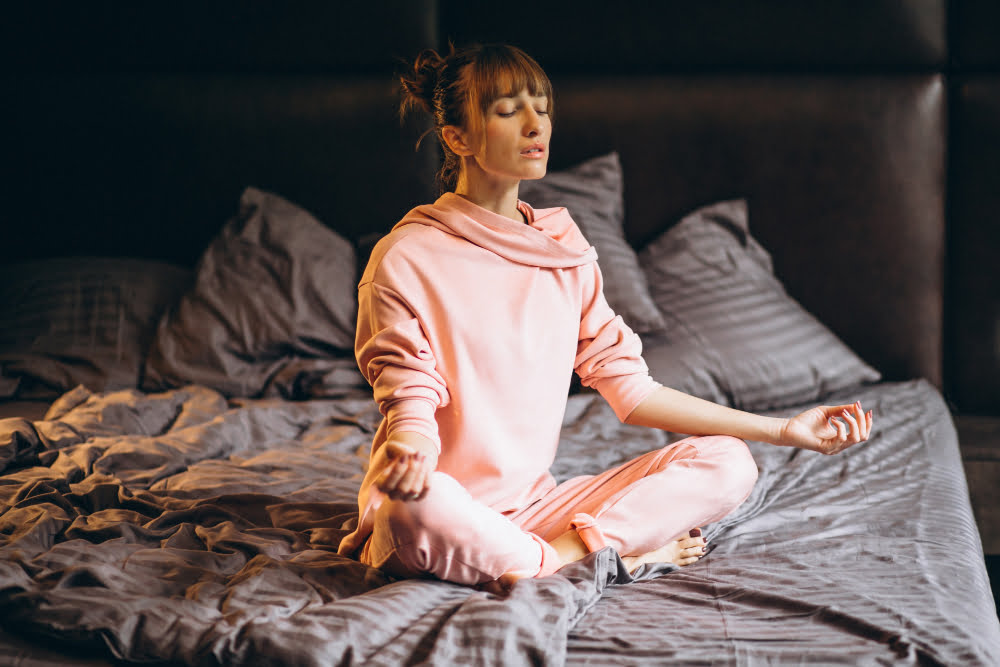
Meditating in bed isn’t about drifting off into sleep, but fostering a restful state that nourishes mind and body. The idea is to promote tranquility and awareness. Employing techniques designed specifically for lying down can enable greater comfort, relaxation, and focus.
1. Comfort: Your bed provides a soft, serene space for meditation.
2. Tranquility: By meditating in a familiar, cozy environment, you are more likely to achieve a peaceful state.
3. Door to Deepened Awareness: Lying down can enable an intimate connection with your physical sensations, laying the foundation for Body Scan meditation.
4. Flexibility: You can meditate either as you wake up or before you sleep, acting as a transition between different states of consciousness.
5. Easy Start: For beginners, the bed is a non-intimidating place to start meditation practices.
Remember, it’s not about falling asleep but fostering a state of wakeful rest.
Meditation Techniques Suitable for Bed

Lying Down Meditation is an effective technique, requiring you simply to lay on your back, palms facing upwards, and breathe naturally. Concentrate on the rise and fall of your abdomen or chest with each breath. It can help alleviate mental clutter.
Progressive Muscle Relaxation, involves tensing and then relaxing each muscle group in your body. Start from your toes, working your way up to the head. This can be instrumental in releasing physical tension and achieving deep relaxation.
Visualisation is a potent tool for calming the mind. Picture pleasing nature scenes or peaceful landscapes, trying to include as many senses as you can – like the scent of flowers or the sound of water.
The Sleep Induction Technique focuses on counting your breaths. Start by counting one as you inhale and two as you exhale, all the way up to ten. If you lose count, simply start back from one. This is an effective way of distracting your mind from daily stresses and anxieties.
Mindful Body Scanning involves shifting your attention through different parts of your body, from your toes to your head, noting any sensations or discomfort without judgment. This technique establishes a mind-body connection that can foster deeper relaxation.
Guided Meditation using an app or online source can guide you through a meditation practice and offer specific routines designed for sleep, such as sleep stories or ambient sounds.
Benefits of Meditating Before Sleep
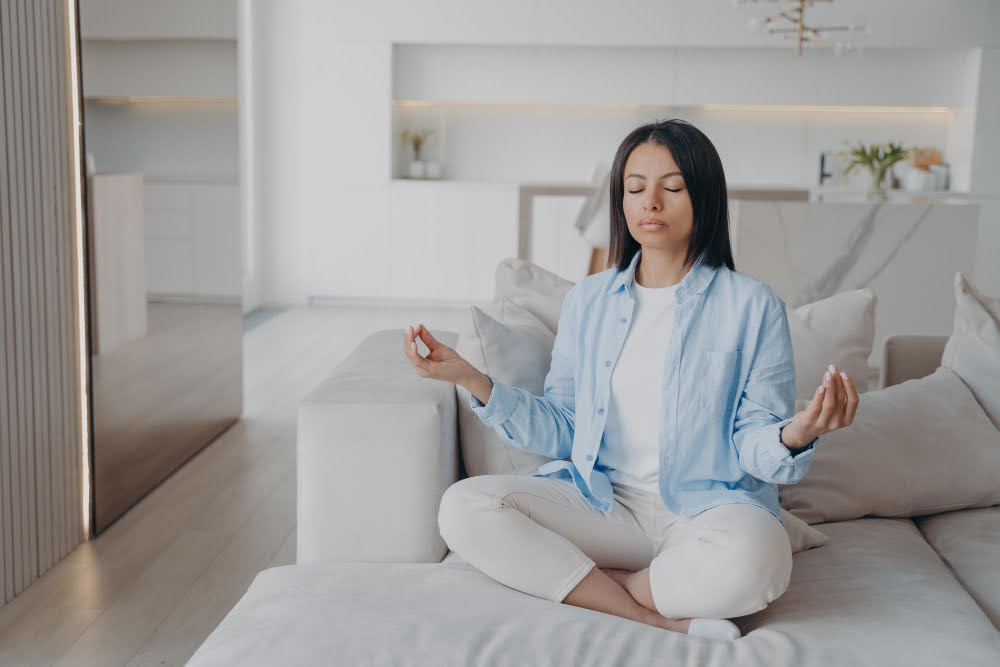
Cultivating a meditation practice before bedtime has many potential benefits. Firstly, it aids in breaking the cycle of insomnia by calming the mind and reducing stress and anxiety. This can, in turn, result in better quality sleep, essential for overall health and wellbeing.
Secondly, pre-sleep meditation enhances melatonin levels, a hormone responsible for sleep regulation, leading to healthier sleep patterns.
Thirdly, these mindfulness moments improve emotional health, aiding in deeper relaxation and faster sleep onset. They can help in dealing with stressful situations by offering a reprieve, a sanctuary of sorts, before stepping into the world of dreams.
Finally, bedtime meditation fosters self-awareness. This mindful journey into one’s inner landscape helps to defragment the day’s experiences promoting personalized cognitive restructuring and preserving mental health.
How Beginners Can Start Meditating in Bed
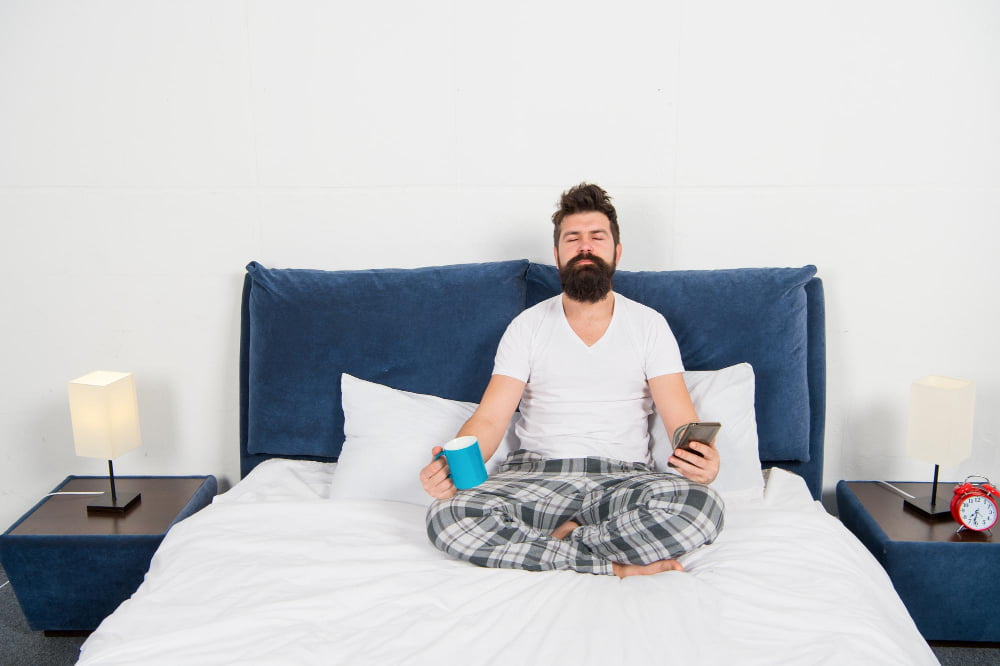
Starting the practice of meditating in bed might seem challenging, but a few simple techniques can make the journey smoother.
1. Create a calming ambiance: Soft lighting, gentle sounds, or pleasant scents can contribute to a peaceful atmosphere that fosters relaxation.
2. Fix a regular schedule: Consistency leads to a habitual response in the body, assisting in easier transition into a meditative state.
3. Find a comfortable position: Lying flat on your back with hands resting at your sides is a good starting point, however, find what’s most suited to your comfort.
4. Use Guided Meditation: As a beginner, using available resources like guided meditation apps or videos can lead the way in the practice.
5. Focus on your breathing: Become aware of your breath. Feel it as it fills your lungs and leaves them. This rhythmic focus will create a foundation for your meditation routine.
6. Acknowledge your thoughts: When random thoughts occur, simply acknowledge them and gently steer back your focus onto the breath.
7. Start small: Begin with brief sessions of around 5-10 minutes and progressively enhance the duration.
Remember, patience is the key to progress. With time, not only will the practice become easier but will also positively impact your sleep quality and overall wellbeing.
Practicing Mindfulness Meditation in Bed
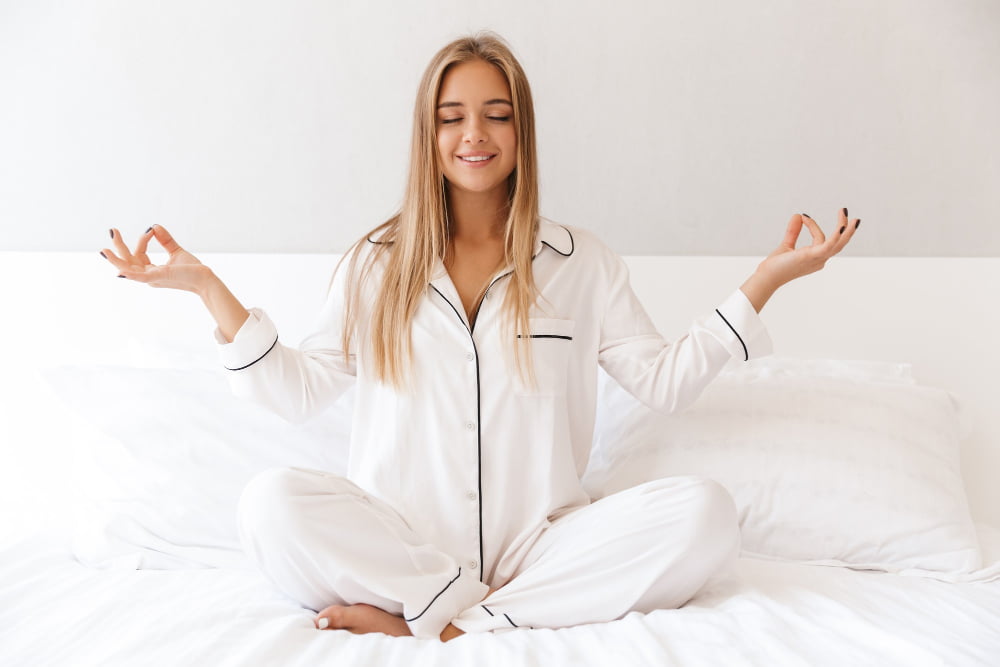
Mindfulness meditation, given its adaptability, is a brilliant way to start or end your day while still in bed. The focus of this form of meditation is to cultivate attention on the body and mental sensation to help develop profound understanding and appreciation of the present moment.
Here are few tips to incorporate mindfulness meditation into your bedtime routine:
- Start by finding a comfortable position. This could be lying down, sat up or reclining. It’s important to ensure that you’re relaxed but not on the verge of falling asleep.
- Gently close your eyes and start by taking deep, slow breaths. Notice the sensation of your breath as it goes in and out.
- Shift attention to your body, from the soles of your feet up to the crown of your head. Acknowledge any sensation, tension, or comfort you feel in each part without attempting to modify it.
- Your mind will inevitably wander. Whenever you notice it has drifted off, gently bring it back to your breath or to whatever body sensation you were focusing on. Your aim isn’t to block the wandering mind but instead to acknowledge it and then refocus.
- Allow yourself to soak in the silence and tranquility. It’s okay if you do not clear your mind completely; the goal is to observe and accept thoughts as they surface without judgement.
By embracing the present, mindfulness meditation can lead to an overall sense of calm, enabling a more restful night’s sleep.
Exploring Body Scan Meditation in Bed

The practice of body scan meditation involves slowly moving your focus through different parts of the body, starting from your toes and gradually moving up towards your head. As you lie comfortably in bed, the goal is to pay attention to various sensations you feel without trying to change them. It’s a time to be present and accept every tickle, tension, or tingle.
Whether it’s noticing the weight of your body against the mattress or feeling the rhythm of your breath, here are some steps to practice:
- 1. Begin with taking a few deep breaths, close your eyes and tune into your body.
- 2. Start directing your attention to the toes of your right foot. Notice any sensations and take a moment there. Continue this with each part of your foot – the heel, the arch, and the top of your foot.
- 3. Gradually move up through your body – your right leg, left foot and leg, hips, lower back, abdomen, chest, arms, fingers, neck, and finally your head.
- 4. Remember to breathe slowly and deeply, giving yourself permission to release tension and relax deeper into your bed.
- 5. If your mind starts to drift, gently guide it back to the area of the body where you left off.
Body scan meditation in bed serves to bring you into a state of deep relaxation that prepares the body for a peaceful and restorative slumber. By exploring and acknowledging your body’s sensations, you cultivate greater body awareness and appreciation, fostering better sleep patterns and overall well-being.
Morning Meditation Techniques in Bed
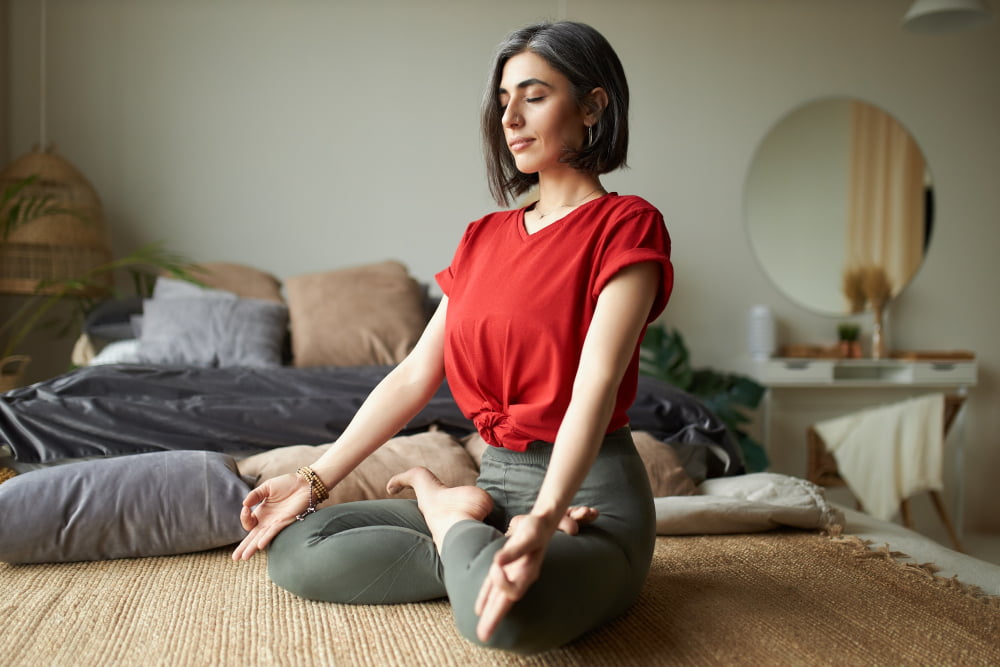
Fresh upon awakening, our minds are often less crowded with thoughts, making morning the perfect time to cultivate mindfulness. These techniques can be practiced right from the comfort of your bed.
1. Equal Breathing: By focusing on inhaling and exhaling equally, you create a rhythm that can calm a busy mind. Start with a four-second breath in, then a four-second breath out. As you get comfortable, lengthen each breath to eight seconds.
2. Visualization: Imagine a place where you feel peaceful and safe. It could be a beach, a forest or anywhere you feel calm. Scan this environment in your mind, focusing on the details.
3. Affirmations: Start your day with a positive figuration. Repeat statements like, “I am calm,” or “I am focused”. Belief in the power of your words can have a profound effect on your mindset throughout the day.
4. Observing Sensations: As you lie in bed, draw your attention to different parts of your body. Begin at your toes and work your way up, noting any sensations or discomfort.
5. Setting Intentions: Think about your goals or the qualities you wish to embody for the day. By setting this intention first thing in the morning, you are more likely to act in alignment with it throughout the day.
Remember, consistency is key when establishing a morning meditation practice. It’s beneficial to find a technique that resonates with you and stick to it. Even a few minutes of mindful wakefulness can set a positive tone for the day.
Guided Meditation Practices for Better Sleep

One effective pathway to restful sleep is incorporating guided meditations. They are led by a narrator or instructor, using soothing voices and calming music, directing your focus to mental images, a series of thoughts, or your own breath. The guidance can help shift your focus from worrying thoughts and promote relaxation.
Choose a guided meditation app or online video to follow along in the comforts of your bed. They come in different lengths, pick one that fits your schedule. Some popular choices include Headspace, Calm, and Insight Timer.
Try a variety of these guided practices to see which works best for you. Focus on the instructions that revolve around controlled breathing exercises, progressive relaxation—where you focus on relaxing each muscle group in turn — and visualizing tranquil scenes to clear your mind.
Remember, patience is key. You may not fall asleep in an instant but with practice, guided meditation could significantly improve your sleep quality.
FAQ
Is it OK to do meditation in bed?
Yes, it is acceptable to meditate in bed as mindfulness can be practiced in any posture.
Should I meditate on my bed or floor?
For optimal mindfulness and alertness during meditation, it’s best to lie on a mat or blanket on the floor, but if practicing sleep meditation, lying down in bed would be suitable.
Can I meditate in bed at night?
Yes, you can meditate in bed at night, focusing on different body parts, and it could help you fall asleep more peacefully.
How does meditating before bedtime impact sleep quality?
Meditating before bedtime can enhance sleep quality by reducing stress, increasing relaxation, and promoting a state conducive to deep sleep.
Does the position of meditation change its effectiveness when performed in bed?
While comfort is paramount, meditating in bed may potentially encourage sleep rather than alert mindfulness; yet, if comfortably cross-legged on the floor is unfeasible, bed meditation practiced upright can still be productive.
What are the techniques to ensure proper mindfulness when meditating in bed?
To ensure proper mindfulness when meditating in bed, focus on your breath, relax your body gradually from toes to head, visualize positive images, and gently usher away intrusive thoughts.